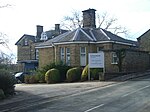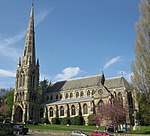Carsick Hall

Carsick Hall is a stone built Victorian Lodge located in the affluent Ranmoor area of Sheffield, South Yorkshire, England, which lies 3 miles west of Sheffield City Centre. Carsick Hall is notable in the area for being built on an old Roman road, near what is now known as Hallam Head. The property sits on a plot inhabited since the writing of the original Domesday Book.Carsick Hall was built in 1842 by Reginald Wood for William Creswick of the renowned Creswick's Silversmiths of Sheffield. A building of this age is rare in Sheffield due to the effects of the German Blitz.'Carsick' is derived from 'Carr', meaning wet woodland and 'Sick' or 'Syke' meaning stream or valley. Carsick Brook passes through the grounds of the hall on its way to the Ponderosa.
Excerpt from the Wikipedia article Carsick Hall (License: CC BY-SA 3.0, Authors, Images).Carsick Hall
Carsick View Road, Sheffield Sandygate
Geographical coordinates (GPS) Address Nearby Places Show on map
Geographical coordinates (GPS)
| Latitude | Longitude |
|---|---|
| N 53.3739 ° | E -1.5372 ° |
Address
Carsick View Road
Carsick View Road
S10 3LZ Sheffield, Sandygate
England, United Kingdom
Open on Google Maps








